

Compact Muon Solenoid
LHC, CERN
| CMS-HIG-14-028 ; CERN-PH-EP-2015-285 | ||
| Measurement of differential and integrated fiducial cross sections for Higgs boson production in the four-lepton decay channel in pp collisions at $\sqrt{s} =$ 7 and 8 TeV | ||
| CMS Collaboration | ||
| 28 December 2015 | ||
| J. High Enery Phys. 04 (2016) 005 | ||
| Abstract: Differential and integrated fiducial cross sections for the production of four leptons via the $ \mathrm{H} \rightarrow 4\ell$ decays ($\ell = \mathrm{e}$, $\mu$) are measured in pp collisions at $\sqrt{s} =$ 7 and 8 TeV. Measurements are performed with data corresponding to integrated luminosities of 5.1 fb$^{-1}$ at 7 TeV, and 19.7 fb$^{-1}$ at 8 TeV, collected with the CMS experiment at the LHC. Differential cross sections are determined as functions of the transverse momentum and rapidity of the four-lepton system, accompanying jet multiplicity, transverse momentum of the leading jet, and difference in rapidity between the Higgs boson candidate and the leading jet. A measurement of the $ \mathrm{Z} \rightarrow 4\ell $ cross section, and its ratio to the $ \mathrm{H} \rightarrow 4\ell $ cross section is also performed. All cross sections are measured within a fiducial phase space defined by the requirements on lepton kinematics and event topology. The integrated $ \mathrm{H} \rightarrow 4\ell $ fiducial cross section is measured to be $ 0.56 ^{\rm +0.67}_{\rm -0.44} \mathrm{(stat)} ^{\rm +0.21}_{\rm -0.06} \mathrm{(syst)} $ fb at 7 TeV, and $ 1.11 ^{\rm +0.41}_{\rm -0.35} \mathrm{(stat)} ^{\rm +0.14}_{\rm -0.10} \mathrm{(syst)} $ fb at 8 TeV. The measurements are found to be compatible with theoretical calculations based on the standard model. | ||
| Links: e-print arXiv:1512.08377 [hep-ex] (PDF) ; CDS record ; inSPIRE record ; CADI line (restricted) ; | ||
| Figures | |

png pdf |
Figure 1-a:
Distributions of the $m_{4\ell }$ observable in 7 TeV (a) and 8 TeV (b) data, as well as expectations for the SM Higgs boson ($m_{\mathrm{H} }=$ 125.0 GeV) and other contributing SM processes, including resonant $ {\mathrm{Z} \to 4\ell }$ decays. |

png pdf |
Figure 1-b:
Distributions of the $m_{4\ell }$ observable in 7 TeV (a) and 8 TeV (b) data, as well as expectations for the SM Higgs boson ($m_{\mathrm{H} }=$ 125.0 GeV) and other contributing SM processes, including resonant $ {\mathrm{Z} \to 4\ell }$ decays. |
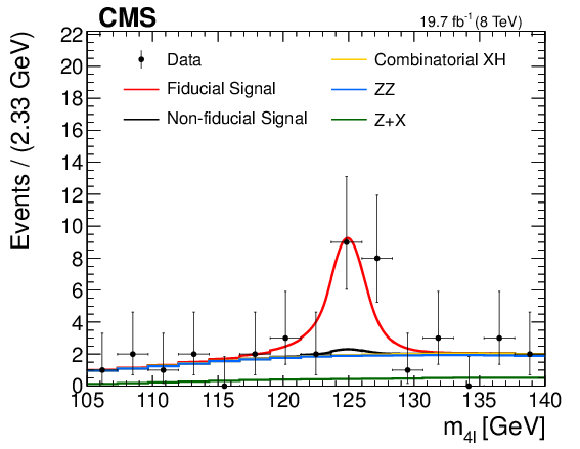
png pdf |
Figure 2-a:
Observed inclusive four-lepton mass distribution and the resulting fits of the signal and background models, presented in Section {sec:Methodology}, in case of an independent $ {\mathrm{H} \to 4\ell }$ fit (a) and a simultaneous $ {\mathrm{H} \to 4\ell }$ and $ {\mathrm{Z} \to 4\ell }$ fit (b). The $\mathrm{g} \mathrm{g} \to \mathrm{H} \to 4\ell $ process is modelled using POWHEG+JHUGen, while $\mathrm{q} \mathrm{ \bar{q} } \to 4\ell $ process is modelled using {\sc Powheg} (both s- and t/u-channels). The sub-dominant component of the Higgs boson production is denoted as XH = VBF + VH + $ {\mathrm{t \bar{t} } \mathrm{H} } $. |

png pdf |
Figure 2-b:
Observed inclusive four-lepton mass distribution and the resulting fits of the signal and background models, presented in Section {sec:Methodology}, in case of an independent $ {\mathrm{H} \to 4\ell }$ fit (a) and a simultaneous $ {\mathrm{H} \to 4\ell }$ and $ {\mathrm{Z} \to 4\ell }$ fit (b). The $\mathrm{g} \mathrm{g} \to \mathrm{H} \to 4\ell $ process is modelled using POWHEG+JHUGen, while $\mathrm{q} \mathrm{ \bar{q} } \to 4\ell $ process is modelled using {\sc Powheg} (both s- and t/u-channels). The sub-dominant component of the Higgs boson production is denoted as XH = VBF + VH + $ {\mathrm{t \bar{t} } \mathrm{H} } $. |

png pdf |
Figure 3:
Results of measurements of the integrated $ {\mathrm{H} \to 4\ell }$ fiducial cross section in pp collisions at 7 and 8 TeV, with a comparison to SM estimates. The red error bar represents the systematic uncertainty, while the black error bar represents the combined statistical and systematic uncertainties, summed in quadrature. The additional systematic effect associated with model dependence is represented by grey boxes. The theoretical estimates at NNLL+NNLO accuracy and the corresponding systematic uncertainties are shown in blue as a function of the centre-of-mass energy. The acceptance of the dominant $ {\mathrm{g} \mathrm{g} \to \mathrm{H} }$ contribution is modelled at the parton level using HRes, and corrected for hadronization and underlying-event effects estimated using POWHEG+JHUGen and Pythia 6.4. |

png pdf |
Figure 4-a:
Results of the differential $ {\mathrm{H} \to 4\ell }$ fiducial cross section measurements and comparison to the theoretical estimates for the transverse momentum (a) and the rapidity (b) of the four-lepton system. The red error bars represent the systematic uncertainties, while black error bars represent the combined statistical and systematic uncertainties, summed in quadrature. The additional systematic uncertainty associated with the model dependence is separately represented by the grey boxes. Theoretical estimates, in which the acceptance of the dominant $ {\mathrm{g} \mathrm{g} \to \mathrm{H} }$ contribution is modelled by POWHEG+JHUGen+PYTHIA, POWHEG MiNLO HJ+PYTHIA, and HRes generators as discussed in Section 3, are shown in blue, brown, and pink, respectively. The sub-dominant component of the signal XH is indicated separately in green. In all estimations the total cross section is normalized to the SM estimate computed at NNLL+NNLO accuracy. Systematic uncertainties correspond to the accuracy of the generators used to derive the differential estimations. The bottom panel shows the ratio of data or theoretical estimates to the HRes theoretical estimations. |

png pdf |
Figure 4-b:
Results of the differential $ {\mathrm{H} \to 4\ell }$ fiducial cross section measurements and comparison to the theoretical estimates for the transverse momentum (a) and the rapidity (b) of the four-lepton system. The red error bars represent the systematic uncertainties, while black error bars represent the combined statistical and systematic uncertainties, summed in quadrature. The additional systematic uncertainty associated with the model dependence is separately represented by the grey boxes. Theoretical estimates, in which the acceptance of the dominant $ {\mathrm{g} \mathrm{g} \to \mathrm{H} }$ contribution is modelled by POWHEG+JHUGen+PYTHIA, POWHEG MiNLO HJ+PYTHIA, and HRes generators as discussed in Section 3, are shown in blue, brown, and pink, respectively. The sub-dominant component of the signal XH is indicated separately in green. In all estimations the total cross section is normalized to the SM estimate computed at NNLL+NNLO accuracy. Systematic uncertainties correspond to the accuracy of the generators used to derive the differential estimations. The bottom panel shows the ratio of data or theoretical estimates to the HRes theoretical estimations. |
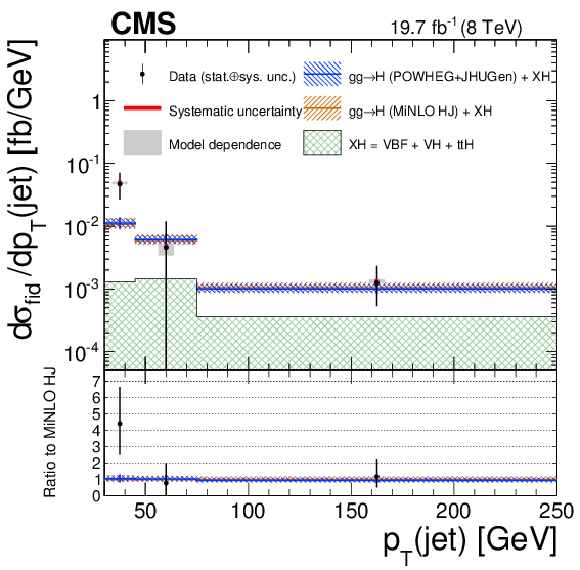
png pdf |
Figure 5-a:
Results of the differential $ {\mathrm{H} \to 4\ell }$ fiducial cross section measurements and comparison to the theoretical estimates for the transverse momentum of the leading jet (a), separation in rapidity between the Higgs boson candidate and the leading jet (b), as well as for the jet multiplicity (c). The red error bars represent the systematic uncertainties, while black error bars represent the combined statistical and systematic uncertainties, summed in quadrature. The additional systematic uncertainty associated with the model dependence is separately represented by the grey boxes. Theoretical estimations, in which the acceptance of the dominant $ {\mathrm{g} \mathrm{g} \to \mathrm{H} }$ contribution is modelled by POWHEG+JHUGen+PYTHIA, and POWHEG MiNLO HJ+PYTHIA generators, as discussed in Section 3, are shown in blue and brown, respectively. The sub-dominant component of the signal XH is indicated separately in green. In all estimations the total cross section is normalized to the SM estimate computed at NNLL+NNLO accuracy. Systematic uncertainties correspond to the accuracy of the generators used to derive the differential estimations. The bottom panel shows the ratio of data or theoretical estimates to the POWHEG MiNLO HJ theoretical estimations. |

png pdf |
Figure 5-b:
Results of the differential $ {\mathrm{H} \to 4\ell }$ fiducial cross section measurements and comparison to the theoretical estimates for the transverse momentum of the leading jet (a), separation in rapidity between the Higgs boson candidate and the leading jet (b), as well as for the jet multiplicity (c). The red error bars represent the systematic uncertainties, while black error bars represent the combined statistical and systematic uncertainties, summed in quadrature. The additional systematic uncertainty associated with the model dependence is separately represented by the grey boxes. Theoretical estimations, in which the acceptance of the dominant $ {\mathrm{g} \mathrm{g} \to \mathrm{H} }$ contribution is modelled by POWHEG+JHUGen+PYTHIA, and POWHEG MiNLO HJ+PYTHIA generators, as discussed in Section 3, are shown in blue and brown, respectively. The sub-dominant component of the signal XH is indicated separately in green. In all estimations the total cross section is normalized to the SM estimate computed at NNLL+NNLO accuracy. Systematic uncertainties correspond to the accuracy of the generators used to derive the differential estimations. The bottom panel shows the ratio of data or theoretical estimates to the POWHEG MiNLO HJ theoretical estimations. |
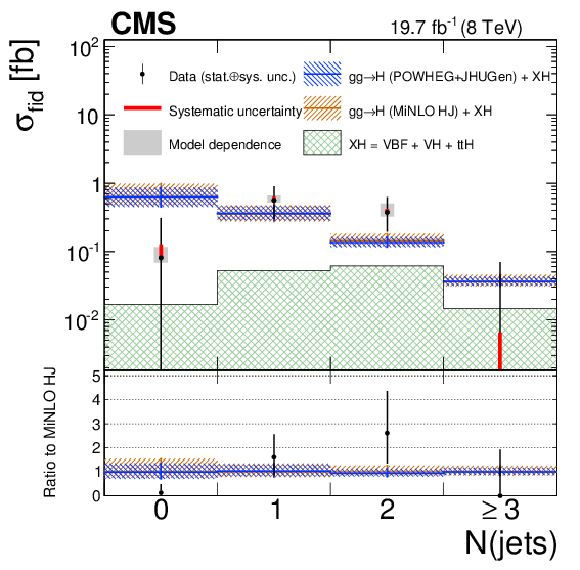
png pdf |
Figure 5-c:
Results of the differential $ {\mathrm{H} \to 4\ell }$ fiducial cross section measurements and comparison to the theoretical estimates for the transverse momentum of the leading jet (a), separation in rapidity between the Higgs boson candidate and the leading jet (b), as well as for the jet multiplicity (c). The red error bars represent the systematic uncertainties, while black error bars represent the combined statistical and systematic uncertainties, summed in quadrature. The additional systematic uncertainty associated with the model dependence is separately represented by the grey boxes. Theoretical estimations, in which the acceptance of the dominant $ {\mathrm{g} \mathrm{g} \to \mathrm{H} }$ contribution is modelled by POWHEG+JHUGen+PYTHIA, and POWHEG MiNLO HJ+PYTHIA generators, as discussed in Section 3, are shown in blue and brown, respectively. The sub-dominant component of the signal XH is indicated separately in green. In all estimations the total cross section is normalized to the SM estimate computed at NNLL+NNLO accuracy. Systematic uncertainties correspond to the accuracy of the generators used to derive the differential estimations. The bottom panel shows the ratio of data or theoretical estimates to the POWHEG MiNLO HJ theoretical estimations. |
| Tables | |
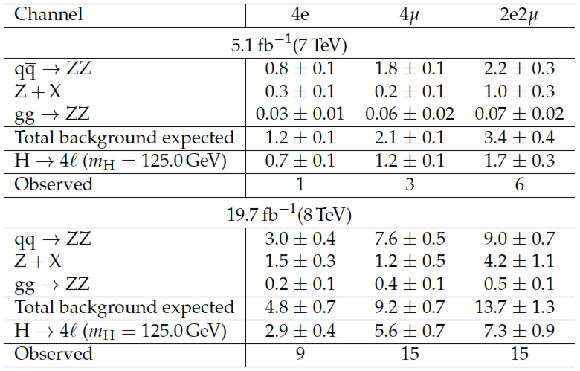
png pdf |
Table 1:
The number of estimated background and signal events, as well as the number of observed candidates, after final inclusive selection in the range $105 < m_{4\ell } < 140 $ GeV, used in the $ {\mathrm{H} \to 4\ell }$ measurements. Signal and $\mathrm{Z} \mathrm{Z} $ background are estimated from simulations, while the $\mathrm{Z} +\mathrm {X}$ background is evaluated using control regions in data. |

png pdf |
Table 2:
Summary of requirements and selections used in the definition of the fiducial phase space for the $ {\mathrm{H} \to 4\ell }$ cross section measurements. For measurements of the $ {\mathrm{Z} \to 4\ell }$ cross section and the ratio of the $ {\mathrm{H} \to 4\ell }$ and $ {\mathrm{Z} \to 4\ell }$ cross sections, the requirement on the invariant mass of the selected four leptons is modified accordingly. More details, including the exact definition of the stable particles and lepton isolation, as well as $\mathrm{Z} _1$ and $\mathrm{Z} _2$ candidates, can be found in the text. |
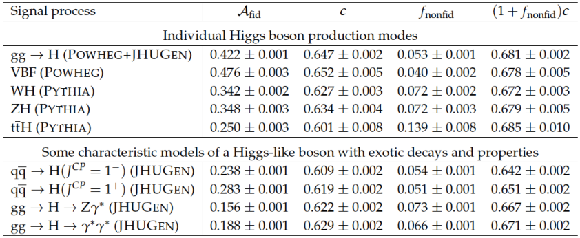
png pdf |
Table 3:
The fraction of signal events within the fiducial phase space (acceptance $\mathcal {A}_{\rm fid}$), reconstruction efficiency ($\epsilon $) for signal events from within the fiducial phase space, and ratio of reconstructed events which are from outside the fiducial phase space to reconstructed events which are from within the fiducial phase space ($f_{\rm nonfid}$). Values are given for characteristic signal models assuming $m_{\mathrm{H} } =$ 125.0 GeV, $\sqrt {s} =$ 8 TeV, and the uncertainties include only the statistical uncertainties due to the finite number of events in MC simulation. In case of the first seven signal models, decays of the Higgs-like boson to four leptons proceed according to SM via the $\mathrm{H} \to \mathrm{Z} \mathrm{Z} ^{*} \to 4\ell $ process. Definition of signal excludes events where at least one reconstructed lepton originates from associated vector bosons or jets. The factor $(1+f_{\rm nonfid})\epsilon $ is discussed in Section {sec:Methodology}. |

png pdf |
Table 4:
Overview of main sources of the systematic uncertainties in the $ {\mathrm{H} \to 4\ell }$ cross section measurements. More details, including the definition of the model dependence are presented in the text. |

png pdf |
Table 5:
Results of the $ {\mathrm{H} \to 4\ell }$ integrated fiducial cross section measurements performed in the $m_{4\ell }$ range from 105 to 140 GeV for pp collisions at 7 and 8 TeV, and comparison to the theoretical estimates obtained at NNLL+NNLO accuracy. Statistical and systematic uncertainties, as well as the model-dependent effects are quoted separately. The sub-dominant component of the Higgs boson production is denoted as XH = VBF + VH + $ { \mathrm{ t \bar{t} } \mathrm{H} } $. |
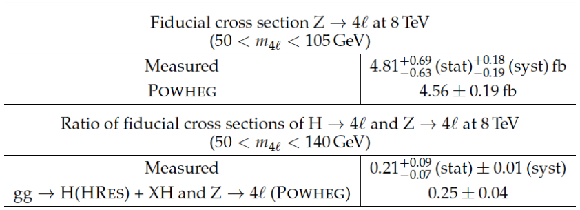
png pdf |
Table 6:
The $ {\mathrm{Z} \to 4\ell }$ integrated fiducial cross section at 8 TeV in the $m_{4\ell }$ range from 50 to 105 GeV, and the ratio of 8 TeV fiducial cross sections of $ {\mathrm{H} \to 4\ell }$ and $ {\mathrm{Z} \to 4\ell }$ obtained from a simultaneous fit of mass peaks of $ {\mathrm{Z} \to 4\ell }$ and $ {\mathrm{H} \to 4\ell }$ in the mass window 50 to 140 GeV. The sub-dominant component of the Higgs boson production is denoted as XH = VBF + VH + $ { \mathrm{ t \bar{t} }\mathrm{H} } $. |
| Summary |
| We have presented measurements of the integrated and differential fiducial cross sections for the production of four leptons via the $\mathrm{H} \rightarrow 4\ell$ decays in pp collisions at centre-of-mass energies of 7 and 8 TeV. The measurements were performed using collision data corresponding to integrated luminosities of 5.1 fb$^{-1}$ at 7 TeV and 19.7 fb$^{-1}$ at 8 TeV. The differential cross sections were measured as a function of the transverse momentum and the rapidity of the four-lepton system, the transverse momentum of the leading jet, the difference in rapidity between the Higgs boson candidate and the leading jet, and the jet multiplicity. Measurements of the fiducial cross section for the production of four leptons via the $\mathrm{Z} \to 4\ell$ decays, as well as its ratio to the $\mathrm{H} \to 4\ell$ cross section, were also performed using the 8 TeV data. The uncertainty in the measurements due to the assumptions in the model of Higgs boson properties was estimated by studying a range of exotic Higgs boson production and spin-parity models. It was found to be lower than 7% of the fiducial cross section. The integrated fiducial cross section for the four leptons production via the $\mathrm{H} \rightarrow 4\ell$ decays is measured to be $ 0.56^{\rm +0.67}_{\rm -0.44} \mathrm{(stat)} ^{\rm +0.21}_{\rm -0.06} \mathrm{(syst)} $ fb and $1.11^{\rm +0.41}_{\rm -0.35} \mathrm{(stat)} ^{\rm +0.14}_{\rm -0.10} \mathrm{(syst)} $ fb at 7 and 8 TeV, respectively. The measurements are found to be compatible with theoretical calculations based on the standard model. |

|
Compact Muon Solenoid LHC, CERN |

|

|

|

|

|

|